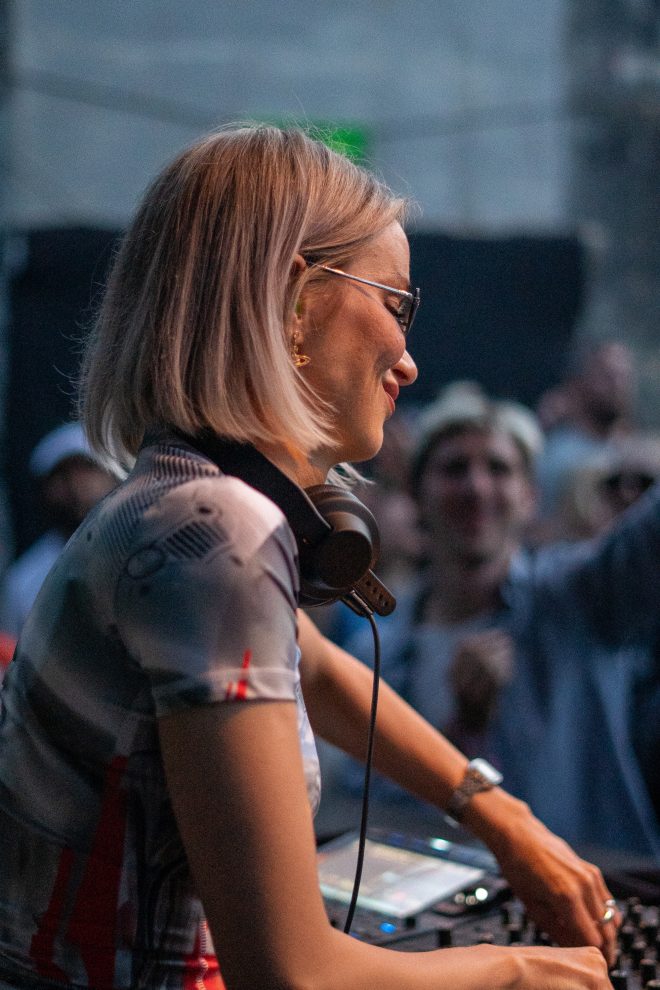Maruwa
An iconic force in electronic music

Maria Believskaia aka Maruwa channels forceful energy, effortlessly blending trance, progressive house, and techno in her productions and on dance floors worldwide. Her signature sound combines the nostalgic elements of the ‘90s and early 2000s, enriched with a modern twist. Now based in (and inspired by) Frankfurt, she has carved her niche with several multifaceted EPs on labels like Steel City Dance Discs and X-Kalay.
Her remixes, on both scene veterans like Dusky, Skream, Catz ‘n’ Dogz, and underground artists like Azo, Subsism, Denham Audio, and others have found their way into the hearts of ravers around the world. One can catch her delivering a long opening at Robert Johnson or a daytime set at Intercell, igniting vigorous mornings at Panorama Bar, or navigating the deeper nights in Nantes Macadam.
In this interview, Maria shares her experiences with hearing damage and the crucial role of earplugs in her career discusses the impact of sober touring on her performances, and reflects on her genrefluid style and the challenges it brings. She also delves into her journey as a DJ and producer, the influence of the 90s on her work, and the evolving attitudes towards women in electronic music. Additionally, Maruwa offers insights into the effects of social media on the DJ industry and the commercialization of the DJ image.
Join us as we explore the multifaceted world of Maruwa, her resilience, and her unwavering commitment to her craft.
HER BEGINNINGS
Maruwa began her music career as a producer before becoming a DJ a few years later. During her teenage years, she produced piano and ambient music, played keys in a rock band, and studied classical piano in musical college. Her brother, who had a home studio and performed at underground clubs, introduced her to electronic dance music and synthesizers, regularly giving her CDs with new electronic music.
Her first track was an EDM big room house tune, followed by a hip-hop phase where she produced chill, instrumental tracks with jazz and soul influences. Despite gaining followers in the USA, she achieved a different success in her own country. Around this time, she started DJing in clubs and aimed to create music for the dancefloor.
“A turning point came when a friend introduced me to lo-fi house producers like DJ Seinfeld and Mall Grab. Their rough, nostalgic sound amazed me, and they were the first producers I shared my tracks with. In 2018, DJ Seinfeld played one of my tunes in a club, a pivotal moment."
"Shortly after, Mall Grab, who had a new label called Steel City Dance Discs, responded to my mail and expressed interest in releasing my tracks. This was a crucial point in my career, marking the beginning of the Maruwa producer and DJ project”.
THE NEW WAVE OF ELECTRONIC MUSIC
Maruwa believes the surge in fast BPMs in electronic dance music post-pandemic was driven by people’s desire for high-energy raves to make up for the long isolation period. The revival of rave culture and the sounds of 90s music played significant roles in this trend. However, after a period dominated by fast-paced beats, she predicts a natural shift towards slower, groovier, and more soulful tracks.
“Music trends often follow cyclical patterns, and after a period of fast-paced music, there might be a shift toward slower, more groovy, and soulful tracks. I believe the BPM will slow down—it’s an inevitable process—but it’s difficult to predict what genre will be the next big thing. I already feel the energy on the dance floors starting to shift, and I’m really curious to see where it will take us”.
Emerging music trends, according to Maruwa, are typically sparked by passionate producers and individuals running independent labels, niche communities, and small clubs. When a local trend gains enough momentum, it can evolve into a mainstream movement and feature on larger festival stages. However, as the market becomes saturated with a particular sound, the trend starts to decline, making room for new and innovative sounds to emerge.
“With the sound I play now, I took a lot of inspiration from the Berlin progressive house scene. However, I also draw a lot of inspiration from the techno scene, including artists like Anetha, Daria Kolosova, DJ Gigola, Hyperaktivist, and Ki/Ki”.
Maruwa attributes the widespread obsession with 90s music in the electronic scene to that era’s golden age of innovation. The 90s saw the advent of affordable synthesizers, drum machines, and samplers, which democratized music production and led to the birth of groundbreaking genres like techno, trance, house, and jungle. This period of experimentation and creativity resonates deeply with her, as it does with many young adults who find comfort in the nostalgia of acarefr ee childhood.
“The ‘90s were a golden era of innovation in music production, when affordable synthesizers, drum machines, and samplers appeared on the market, which enabled more people to produce music."
"Experiments with equipment and sound gave rise to genres like techno, trance, house, and jungle. Apart from that, for many young adults, the 90s evoke memories of carefree childhood, and recalling these nostalgic moments can feel very comforting nowadays, especially given the current global instability with ongoing wars”.
“In my sets, I play a lot of old tunes from the 90s and 2000s, blending them with contemporary productions. This allows me to create a nostalgicyet fresh experience”.
Her enthusiasm for the future of electronic music is palpable. She sees the current shifts and changes as part of a larger, exciting evolution in the scene. As trends rise and fall, she remains committed to exploring new sounds and keeping her sets dynamic and engaging. Her journey from producing piano and ambient music as a teenager to becoming a renowned DJ and producer reflects her passion and dedication to her craft. With each performance, she continues to push the envelope, creating unforgettable experiences for her audiences and contributing to the ever-evolving landscape of electronic music.
EXPERIENCE WITH HEARING DAMAGE AND MANAGING IT AS A DJ
“After three years of DJing weekly, I suddenly lost the ability to hear high frequencies in one ear, It took me three weeks to recover from that. I made custom earplugs but initially found them uncomfortable for mixing, so I only wore them outside of performances. Three years later, I experienced the same issue again after ADE 2023, leading to a month-long recovery period. I had to learn to perform with earplugs, making mistakes at first but ultimately finding it better than risking deafness. Now, I never enter a club without earplugs. DJS must use earplugs from the start and get used to mixing with them to protect their hearing. Immediate medical attention and therapy are essential for sudden hearing loss to prevent permanent damage or tinnitus”.
“Start using earplugs as soon as you begin DJing. Although it might initially be uncomfortable and lead to mistakes, it’s crucial for longterm hearing health. Consistency and practice with earplugs are key, and over time, it will become second nature”.
This message not only shares a significant personal story but also offers practical and educational advice to the DJ community on the importance of auditory protection from the beginning of their careers.

ELECTRONIC MUSIC AND WOMEN
“When I started my career as a music producer in 2015, I remember hearing advice like, don’t try to break into this genre; men dominate it. It’s impossible to succeed there as a woman, even if your music is good. Of course, things have improved significantly since then, and attitudes towards women and all FLINTA artists in the art and electronic music fields have gotten better. However, I believe further progress is still needed. We are still far from achieving true equality and inclusivity”.
“While many promoters book female and FLINTA artists just to “check the box,” some genres of electronic dance music remain male-dominated, and FLINTA and queer artists are still underrepresented in headlining festival slots. Additionally, it is important to see more FLINTA individuals in leadership and technical positions at clubs and festivals. This would help to drive systematic change from within. Despite these challenges, it ́s great to see many small festivals, clubs, and organizations actively promoting diversity and inclusion”.
“I hope to see more of these initiatives in the future, becoming standard practice even for mainstream festivals. FLINTA and queer artists deserve to feel respected and supported in their work environments, free from harassment anddiscrimin ation, and to have the same creative freedom as their peers”.
Regarding social media, Maria sees it as a powerful tool for visibility and community building, allowing artists to reach large audiences without massive marketing campaigns. However, she also recognizes the downsides, such as the pressure to maintain a certain image, which can detract from the artistic process.
“The pressure to maintain a certain image can detract from the artistic process. Not every DJ and artist is comfortable showing their lifestyle, behind-the-scenes activities, and personal interests, but nowadays it seems an essential part of the game that cannot be skipped. For example, it’s difficult for me to imagine that artists like Burial or Deadmau5 (or any artist who prefers not to reveal their face) would grow as quickly today as artists who regularly post selfies and videos from performances”.
“While I see a lot of talented artists struggling with social media at the moment, I hope that in the future, we can find a good balance and adapt to rapid technological progression”.


